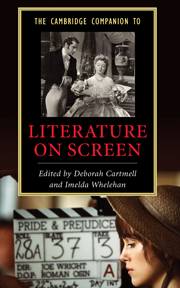Book contents
- Frontmatter
- Introduction - Literature on screen: a synoptic view
- Part One Theories of Literature on Screen
- Part Two History and Contexts
- 3 Gospel narratives on silent film
- 4 William Shakespeare, filmmaker
- 5 The nineteenth-century novel on film: Jane Austen
- 6 Modernism and adaptation
- 7 Postmodern adaptation: pastiche, intertextuality and re-functioning
- Part Three Genre, Industry, Taste
- Part Four Beyond the "Literary"
- Further reading
- Index
- Series List
3 - Gospel narratives on silent film
from Part Two - History and Contexts
Published online by Cambridge University Press: 28 September 2007
- Frontmatter
- Introduction - Literature on screen: a synoptic view
- Part One Theories of Literature on Screen
- Part Two History and Contexts
- 3 Gospel narratives on silent film
- 4 William Shakespeare, filmmaker
- 5 The nineteenth-century novel on film: Jane Austen
- 6 Modernism and adaptation
- 7 Postmodern adaptation: pastiche, intertextuality and re-functioning
- Part Three Genre, Industry, Taste
- Part Four Beyond the "Literary"
- Further reading
- Index
- Series List
Summary
In the silent era, the film industry reached early, eagerly, and repeatedly for literary sources of a more or less reputable character to feed its voracious hunger for narrative material. The authors enlisted to supply a good plot line and some associated cultural kudos included Dickens, Thackeray, Hugo, Pushkin, Racine, Goldsmith, Twain, Wilde and, most frequently of all, Shakespeare. Filmmakers on both sides of the Atlantic gratefully embraced the respectability that adapting the “classics” could bring and were widely applauded for doing so. Impressive claims were made about what a Shakespeare picture, for example, might do both for a viewing public in need of cultural and moral edifying and for an industry in need of rescuing from its own worst impulses. Aligning itself with an established literary pedigree was an economical route towards artistic legitimacy and moral propriety for an industry keenly aware that, initially at least, it lacked both.
If establishment respectability was what was required of a literary source, the Christian Bible did not just offer it, it was it. It is, therefore, no surprise that the film industry appropriated biblical material strikingly early in its own development. Making such films was not, however, a project without potential pitfalls. Adapting any known literary work for the screen is a delicate business. It runs the risk of irritating those most intensely invested in the particular character, history and perceived cultural value of the source. Nevertheless, adapting sections of the Bible has proved difficult to rival in the sphere of literary adaptation for the strength of the competing responses it can provoke.
- Type
- Chapter
- Information
- The Cambridge Companion to Literature on Screen , pp. 47 - 60Publisher: Cambridge University PressPrint publication year: 2007
- 3
- Cited by

